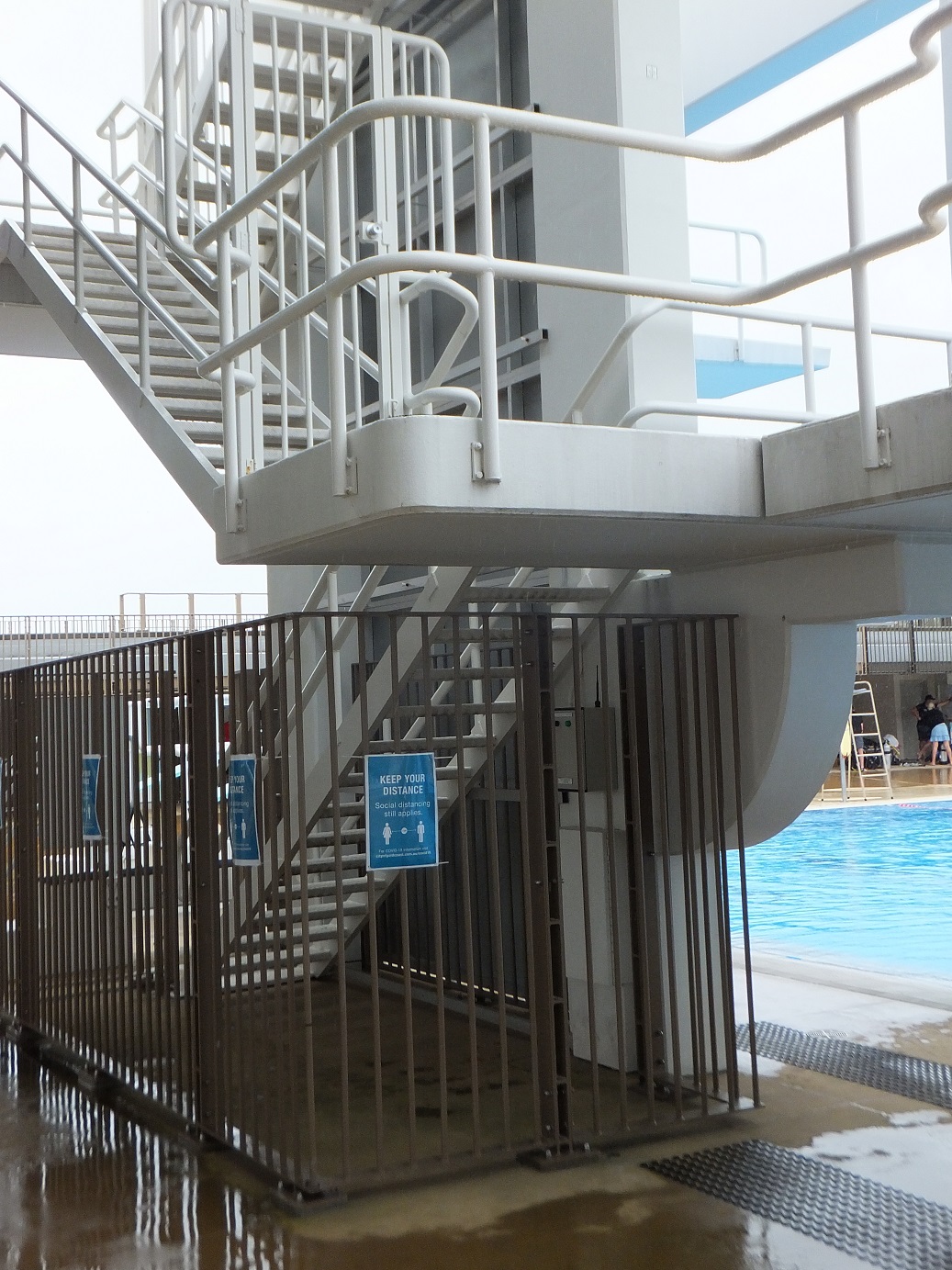Diving tower edge protection
Issued: 17/05/2021
Last Updated: 17/05/2021
Purpose
This safety alert highlights the risk of falls from diving tower structures and provides guidance on risk controls. It applies to parts of diving towers where there is a risk of someone falling onto a solid structure below. It does not apply to parts of diving towers directly above water.
Background
In early 2021 there was a serious incident involving a four-year-old at a swimming pool facility in Queensland. The child fell nearly three metres onto concrete from the first level of a multi-level dive tower. Photographs 1 and 2 show where the child fell from. The exact circumstances of the incident are not known, but it appears the child slipped under the mid-rail of the barrier.
Photograph 1: Area where fall occurred.
Photograph 2: Edge where fall occurred
The Building Code of Australia (BCA) requires that, for particular types of buildings, a ‘continuous barrier be provided alongside a trafficable surface’ including balconies, decks, and stairways, where it is possible to fall one metre or more measured from the level of a trafficable surface to the surface beneath.
Further guidance on performance requirements of barriers to prevent falls is in the BCA, for example:
- The intent of the barrier requirements is to prescribe provisions to minimise the risk of a person falling from a stairway, raised floor level (such as a balcony, landing or the like).
- Children are at particular risk of falling off, over or through ineffectively designed or constructed barriers. Accordingly, the requirements of the BCA aim to ensure that a barrier reduces the likelihood of children being able to climb or fall through a barrier.
Despite the above, it appears that diving towers may fall outside the definition of a building/structure that is required to comply with the continuous barrier requirements of the BCA.
Contributing factors
Falls can occur from elevated platforms for a number of reasons, including inadequate edge protection. On diving towers, the risk is increased as the structure is often wet and there is a greater risk of slipping. The risk of falls for children can be greater as they are smaller and are more likely to fit through openings in a barrier. In addition, children can often take impulsive actions without assessing the potential consequences (e.g. running, climbing, and sitting on a barrier). Therefore, risk controls need to account for situations where children are permitted to use diving towers.
Even if a structure has been inspected and approved as compliant with the BCA it does not guarantee that an incident will not occur, nor does it demonstrate duties under the Work Health and Safety Act 2011 have been fulfilled.
Action required
If you are an operator of a swimming pool facility, you have duties as a person conducting a business or undertaking under the Work Health and Safety Act 2011. These duties apply for workers and people using the facility (e.g. members of the public) and include the need for buildings and structures to be safe for their intended use.
Edge protection
Irrespective of the how a diving tower is defined under the BCA, operators need to ensure the risk of falling from one level to another or to the ground is eliminated, or if that is not possible, minimised. Continuous barrier edge protection requirements under ‘Access and Egress’ provisions of the BCA provide control measures for this. Edge protection should be provided as a continuous barrier so that children cannot fall through, or easily climb over, the barrier. One example is fitting a polycarbonate barrier to the inside of the edge protection. The type of barrier fitted should be fit for the specific application. A building practitioner’s advice should be obtained on a suitable barrier and how it is to be fitted. The barrier should not create a risk of cutting and or abrasions to people. The barrier should not allow a toe hold for small children so that it can be climbed.
Owners of swimming pool facilities should take steps to do this as soon as practicable. Until these barriers are fitted, additional procedures and a higher degree of supervision will need to be applied by operators of swimming pool facilities.
Safety procedures and rules
Operators of swimming pool facilities must ensure that, in addition to suitable engineering/building controls, comprehensive administrative controls are in-place. This can include a combination of rules, signage, and supervision by trained staff. While water safety can be a focus of pool staff, there is also a need to be mindful of the potential for injuries to occur out of the water, including those due to falls from one level to another.

